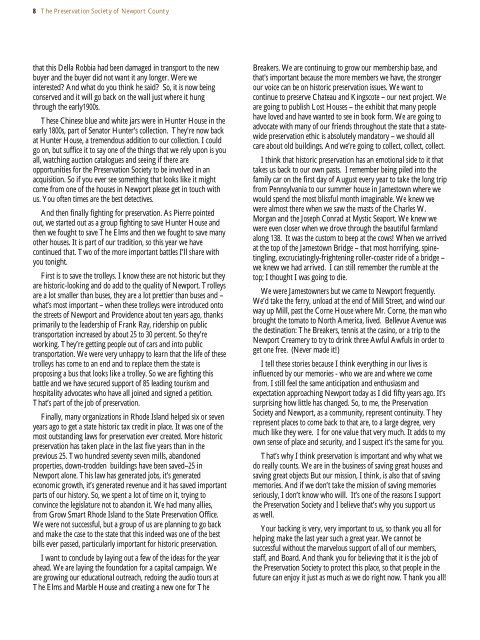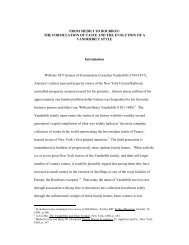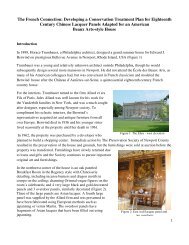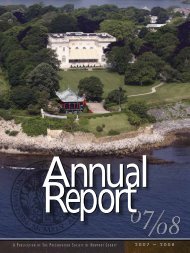Annual Report - Newport Mansions
Annual Report - Newport Mansions
Annual Report - Newport Mansions
You also want an ePaper? Increase the reach of your titles
YUMPU automatically turns print PDFs into web optimized ePapers that Google loves.
8 The Preservation Society of <strong>Newport</strong> County<br />
that this Della Robbia had been damaged in transport to the new<br />
buyer and the buyer did not want it any longer. Were we<br />
interested? And what do you think he said? So, it is now being<br />
conserved and it will go back on the wall just where it hung<br />
through the early1900s.<br />
These Chinese blue and white jars were in Hunter House in the<br />
early 1800s, part of Senator Hunter’s collection. They're now back<br />
at Hunter House, a tremendous addition to our collection. I could<br />
go on, but suffice it to say one of the things that we rely upon is you<br />
all, watching auction catalogues and seeing if there are<br />
opportunities for the Preservation Society to be involved in an<br />
acquisition. So if you ever see something that looks like it might<br />
come from one of the houses in <strong>Newport</strong> please get in touch with<br />
us. You often times are the best detectives.<br />
And then finally fighting for preservation. As Pierre pointed<br />
out, we started out as a group fighting to save Hunter House and<br />
then we fought to save The Elms and then we fought to save many<br />
other houses. It is part of our tradition, so this year we have<br />
continued that. Two of the more important battles I’ll share with<br />
you tonight.<br />
First is to save the trolleys. I know these are not historic but they<br />
are historic-looking and do add to the quality of <strong>Newport</strong>. Trolleys<br />
are a lot smaller than buses, they are a lot prettier than buses and –<br />
what’s most important – when these trolleys were introduced onto<br />
the streets of <strong>Newport</strong> and Providence about ten years ago, thanks<br />
primarily to the leadership of Frank Ray, ridership on public<br />
transportation increased by about 25 to 30 percent. So they’re<br />
working. They’re getting people out of cars and into public<br />
transportation. We were very unhappy to learn that the life of these<br />
trolleys has come to an end and to replace them the state is<br />
proposing a bus that looks like a trolley. So we are fighting this<br />
battle and we have secured support of 85 leading tourism and<br />
hospitality advocates who have all joined and signed a petition.<br />
That’s part of the job of preservation.<br />
Finally, many organizations in Rhode Island helped six or seven<br />
years ago to get a state historic tax credit in place. It was one of the<br />
most outstanding laws for preservation ever created. More historic<br />
preservation has taken place in the last five years than in the<br />
previous 25. Two hundred seventy seven mills, abandoned<br />
properties, down-trodden buildings have been saved–25 in<br />
<strong>Newport</strong> alone. This law has generated jobs, it’s generated<br />
economic growth, it’s generated revenue and it has saved important<br />
parts of our history. So, we spent a lot of time on it, trying to<br />
convince the legislature not to abandon it. We had many allies,<br />
from Grow Smart Rhode Island to the State Preservation Office.<br />
We were not successful, but a group of us are planning to go back<br />
and make the case to the state that this indeed was one of the best<br />
bills ever passed, particularly important for historic preservation.<br />
I want to conclude by laying out a few of the ideas for the year<br />
ahead. We are laying the foundation for a capital campaign. We<br />
are growing our educational outreach, redoing the audio tours at<br />
The Elms and Marble House and creating a new one for The<br />
Breakers. We are continuing to grow our membership base, and<br />
that's important because the more members we have, the stronger<br />
our voice can be on historic preservation issues. We want to<br />
continue to preserve Chateau and Kingscote – our next project. We<br />
are going to publish Lost Houses – the exhibit that many people<br />
have loved and have wanted to see in book form. We are going to<br />
advocate with many of our friends throughout the state that a statewide<br />
preservation ethic is absolutely mandatory – we should all<br />
care about old buildings. And we’re going to collect, collect, collect.<br />
I think that historic preservation has an emotional side to it that<br />
takes us back to our own pasts. I remember being piled into the<br />
family car on the first day of August every year to take the long trip<br />
from Pennsylvania to our summer house in Jamestown where we<br />
would spend the most blissful month imaginable. We knew we<br />
were almost there when we saw the masts of the Charles W.<br />
Morgan and the Joseph Conrad at Mystic Seaport. We knew we<br />
were even closer when we drove through the beautiful farmland<br />
along 138. It was the custom to beep at the cows! When we arrived<br />
at the top of the Jamestown Bridge – that most horrifying, spinetingling,<br />
excruciatingly-frightening roller-coaster ride of a bridge –<br />
we knew we had arrived. I can still remember the rumble at the<br />
top; I thought I was going to die.<br />
We were Jamestowners but we came to <strong>Newport</strong> frequently.<br />
We’d take the ferry, unload at the end of Mill Street, and wind our<br />
way up Mill, past the Corne House where Mr. Corne, the man who<br />
brought the tomato to North America, lived. Bellevue Avenue was<br />
the destination: The Breakers, tennis at the casino, or a trip to the<br />
<strong>Newport</strong> Creamery to try to drink three Awful Awfuls in order to<br />
get one free. (Never made it!)<br />
I tell these stories because I think everything in our lives is<br />
influenced by our memories - who we are and where we come<br />
from. I still feel the same anticipation and enthusiasm and<br />
expectation approaching <strong>Newport</strong> today as I did fifty years ago. It’s<br />
surprising how little has changed. So, to me, the Preservation<br />
Society and <strong>Newport</strong>, as a community, represent continuity. They<br />
represent places to come back to that are, to a large degree, very<br />
much like they were. I for one value that very much. It adds to my<br />
own sense of place and security, and I suspect it’s the same for you.<br />
That’s why I think preservation is important and why what we<br />
do really counts. We are in the business of saving great houses and<br />
saving great objects But our mission, I think, is also that of saving<br />
memories. And if we don’t take the mission of saving memories<br />
seriously, I don’t know who will. It’s one of the reasons I support<br />
the Preservation Society and I believe that’s why you support us<br />
as well.<br />
Your backing is very, very important to us, so thank you all for<br />
helping make the last year such a great year. We cannot be<br />
successful without the marvelous support of all of our members,<br />
staff, and Board. And thank you for believing that it is the job of<br />
the Preservation Society to protect this place, so that people in the<br />
future can enjoy it just as much as we do right now. Thank you all!





